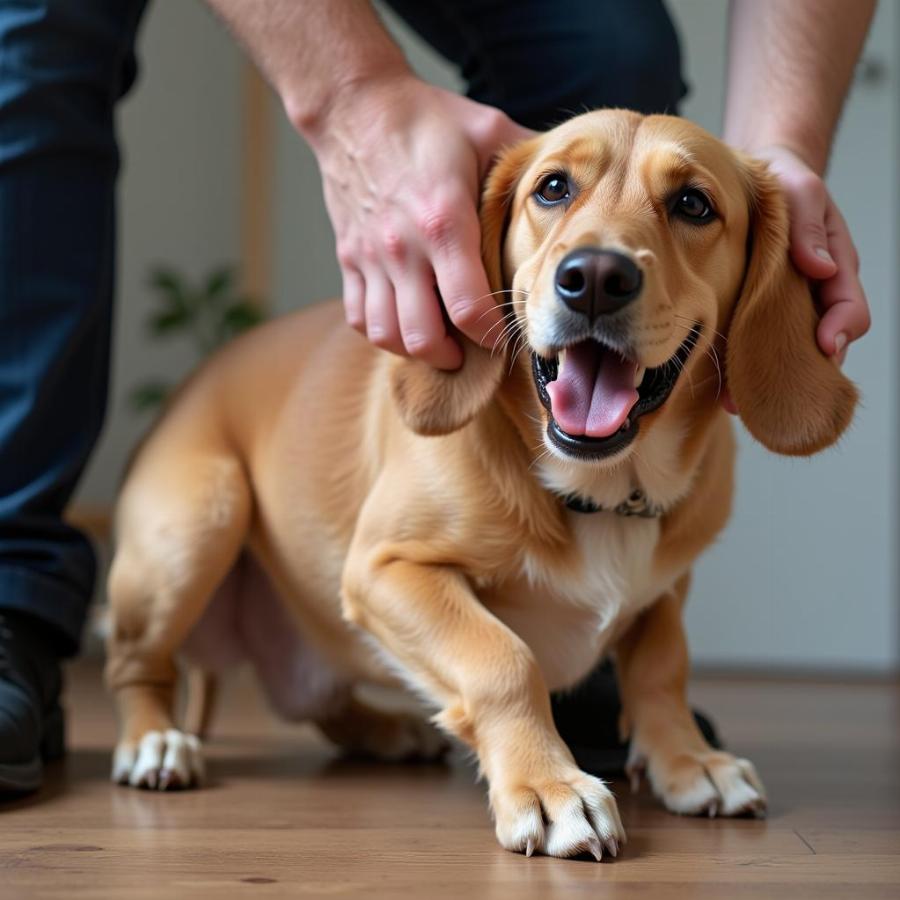Understanding your dog’s vocalizations is key to strengthening your bond. While tail wags and happy barks are easy to interpret, groans can be a bit more mysterious. So, why does your dog groan when you pet him? It’s likely not what you think. Contrary to popular belief, groaning isn’t always a sign of pain or discomfort. More often, it indicates contentment, pleasure, or even a mild form of anxiety. Let’s delve into the reasons behind those doggy groans and learn how to differentiate between a happy groan and one that signals a potential problem.
Decoding Your Dog’s Groans: Pleasure or Pain?
Dog groans can be tricky to interpret, as they can express a range of emotions. The context surrounding the groan, such as your dog’s body language and the specific situation, is crucial to understanding its meaning. Is your dog stretched out, relaxed, and enjoying a belly rub? The groan is probably a sign of pure bliss. However, if the groan is accompanied by tense muscles, lip licking, or avoidance, it could indicate discomfort or pain.
Is Your Dog Groaning From Pure Enjoyment?
Just like humans sigh with contentment, dogs may groan when experiencing pleasure. A soft, low groan while being petted is often a sign your dog is enjoying the attention and feeling relaxed. They might also groan while snuggling up next to you on the couch or when you scratch that perfect spot behind their ears. This type of groan is typically accompanied by relaxed body language, like a loose posture, soft eyes, and a gentle wagging tail. It’s the doggy equivalent of a happy sigh!
Signs Your Dog is Groaning With Pleasure:
- Relaxed body posture
- Soft, gentle groans
- Loose, wagging tail
- Half-closed or soft eyes
- Leaning into your touch
Could Your Dog’s Groans Signal Discomfort?
While many dog groans are associated with pleasure, they can also indicate discomfort or pain. If your dog groans when you touch a specific area, it’s crucial to pay attention. They could be experiencing pain from an injury, arthritis, or other underlying medical condition. A pain-related groan might sound different—higher-pitched, sharper, or more forceful—than a contentment groan. It’s also likely to be accompanied by other signs of discomfort, such as limping, whining, or changes in behavior.
Signs Your Dog is Groaning From Discomfort or Pain:
- Tense muscles
- Lip licking or yawning
- Avoidance of touch
- Changes in appetite or sleep patterns
- Whimpering or yelping
- Limping or favoring a limb
 Dog groaning in pain while being touched
Dog groaning in pain while being touched
What to Do If Your Dog Groans When Petted
If your dog groans when you pet him, the first step is to observe his body language and the surrounding context. Does he seem relaxed and happy, or tense and uncomfortable? If you suspect your dog’s groans are due to pain or discomfort, it’s essential to consult with a veterinarian. They can perform a thorough examination to determine the underlying cause and recommend appropriate treatment. If your dog keeps stretching after groaning, it could indicate stiffness or discomfort. Read more about it in our article on dog keeps stretching.
Groaning and Other Vocalizations
Groaning is just one of many ways dogs communicate. Understanding the nuances of canine communication can help you better understand your furry friend’s needs and emotions. Pay attention to their other vocalizations, like barks, whines, and yelps, as well as their body language, such as tail wags, ear position, and overall posture. Similar to how some dogs groan while being petted, some might also moan when lying down, which could be related to comfort or potential discomfort. Learn more about this in our article on dog moans when lying down.
Conclusion
Deciphering your dog’s groans requires careful observation and consideration of the surrounding context. While a soft groan during a petting session is often a sign of pure enjoyment, a groan accompanied by signs of discomfort or pain warrants a visit to the veterinarian. By paying attention to your dog’s vocalizations and body language, you can deepen your understanding of their needs and ensure their well-being. So, the next time your dog groans when you pet him, take a moment to observe and interpret. You might be surprised by what you discover!
FAQ
-
Is it normal for dogs to groan when being petted? Yes, it’s perfectly normal for dogs to groan when being petted, especially if they are enjoying the attention and feeling relaxed.
-
How can I tell if my dog is groaning from pleasure or pain? Pay close attention to your dog’s body language. Relaxed posture, soft eyes, and a loose wagging tail usually indicate pleasure. Tense muscles, lip licking, avoidance, and other signs of distress suggest pain or discomfort.
-
Should I be concerned if my dog groans when I touch a specific area? Yes, if your dog groans when you touch a specific area, it’s important to consult a veterinarian, as this could indicate an underlying medical condition.
-
What should I do if my dog groans frequently, even when not being petted? Frequent groaning, especially if accompanied by other behavioral changes, warrants a veterinary check-up.
-
Can dog groans be a sign of anxiety? Yes, in some cases, groaning can be a sign of anxiety or stress.
-
Are there any other vocalizations I should be aware of? Yes, pay attention to other vocalizations such as barks, whines, yelps, and howls, as they can also provide insights into your dog’s emotional state.
-
What if my dog eats things he shouldn’t, like fake dog poo? If your dog has a habit of eating inappropriate items, you may find this article about fake dog poo helpful for understanding and addressing the behavior.